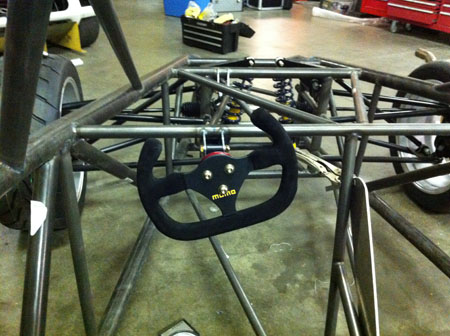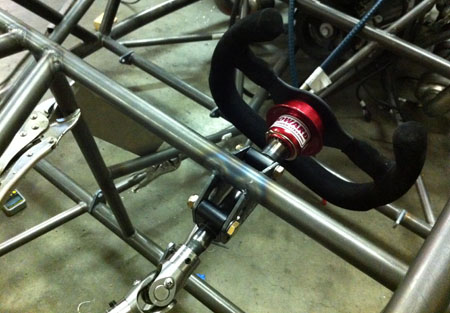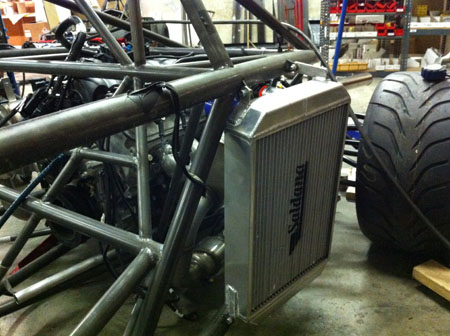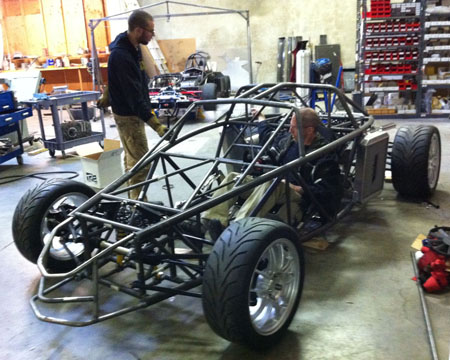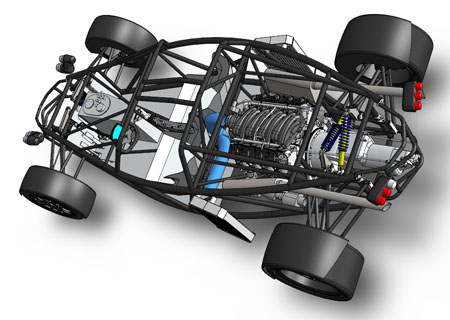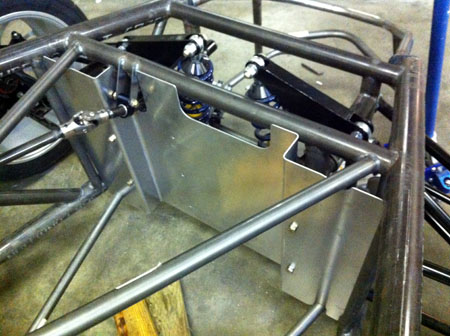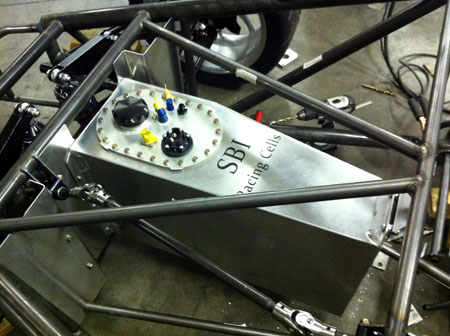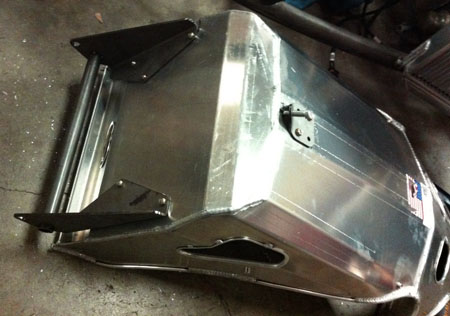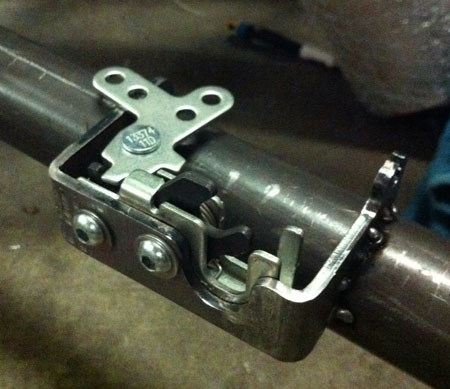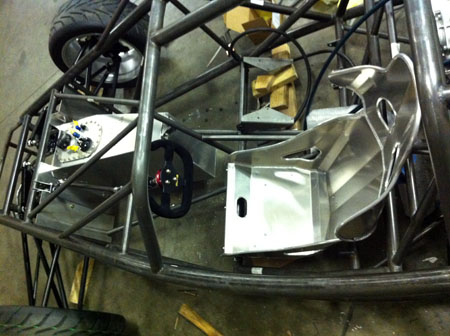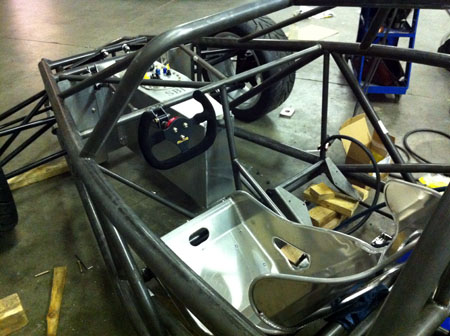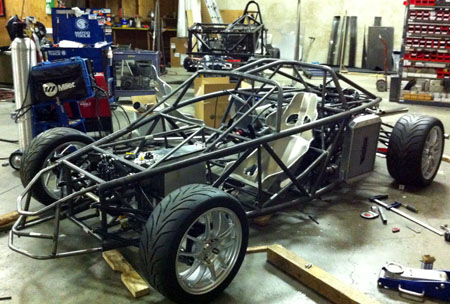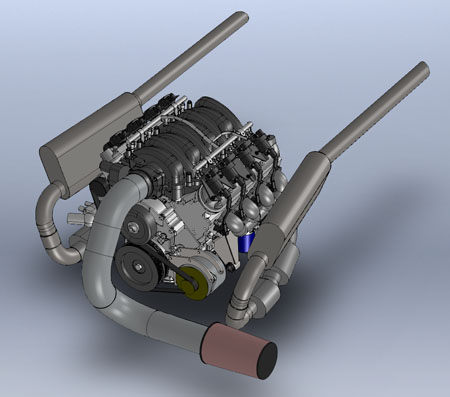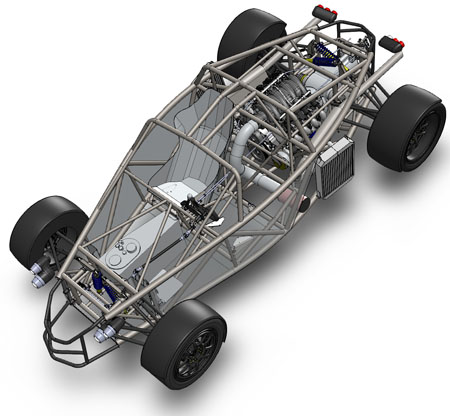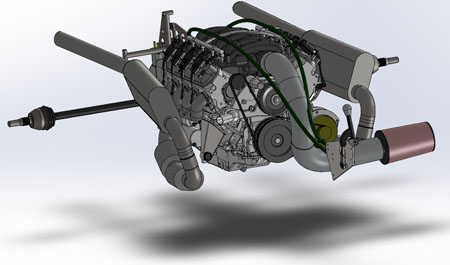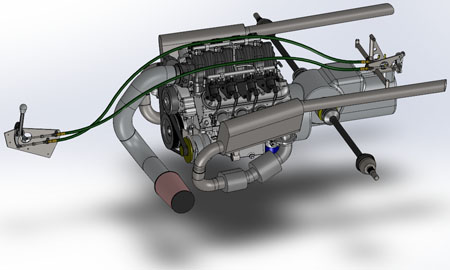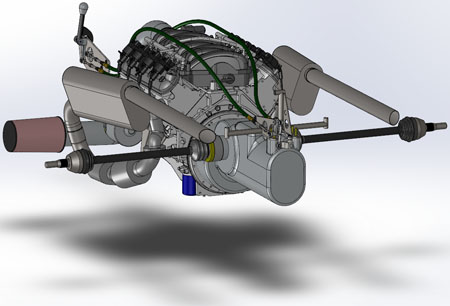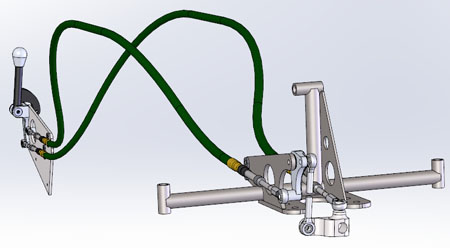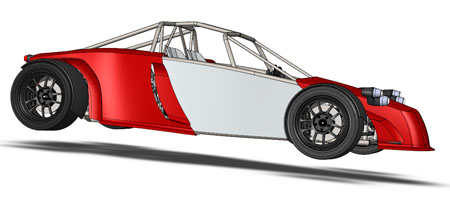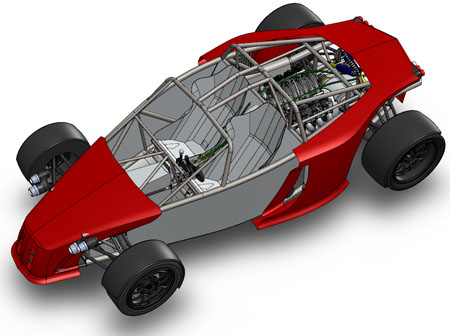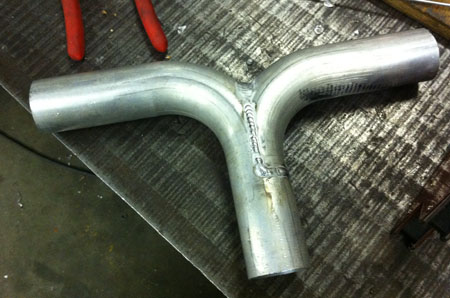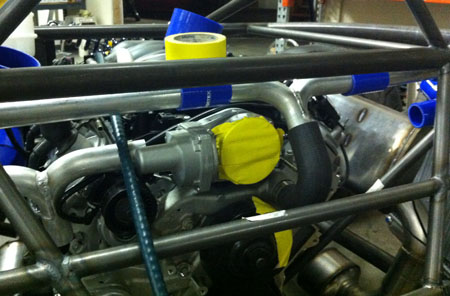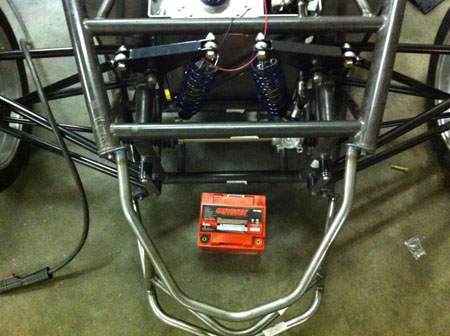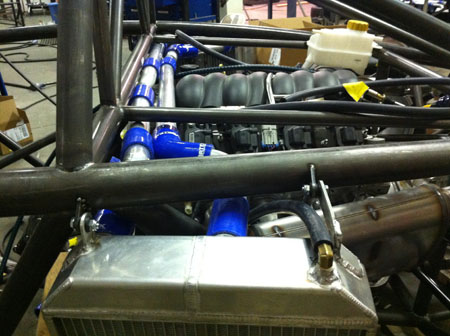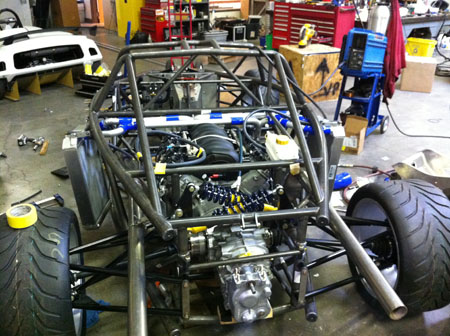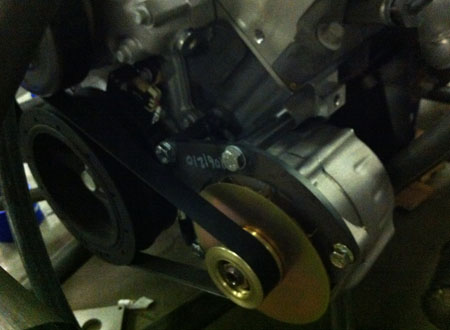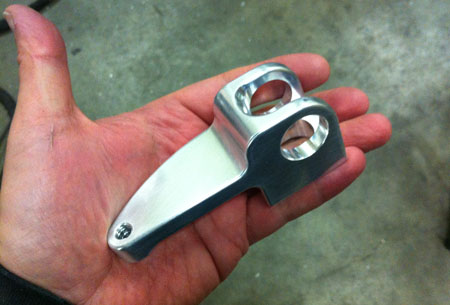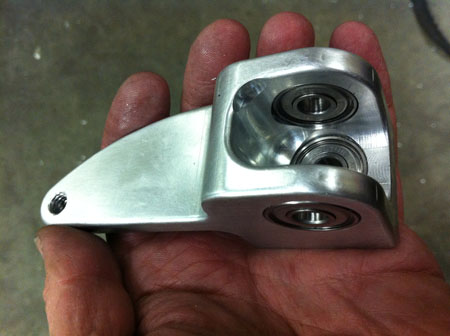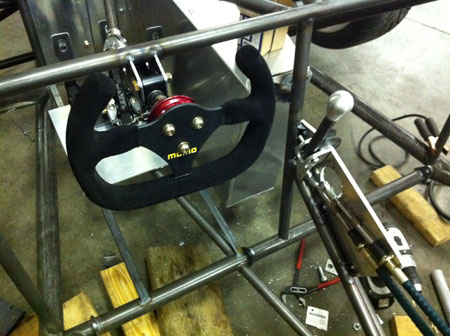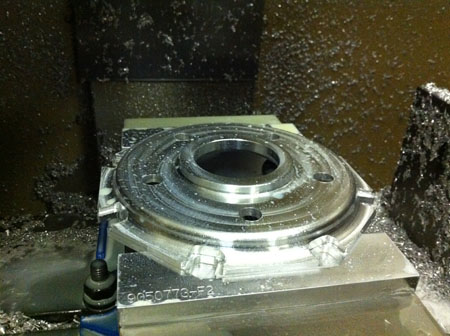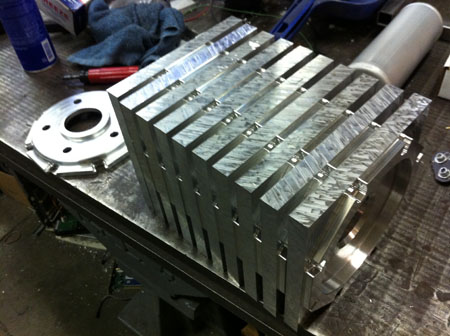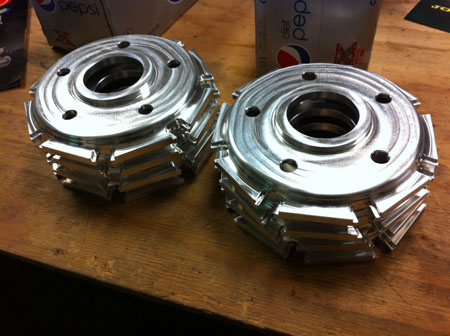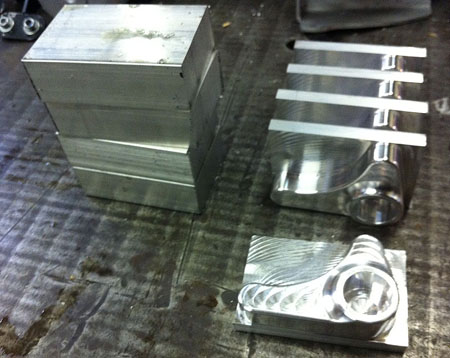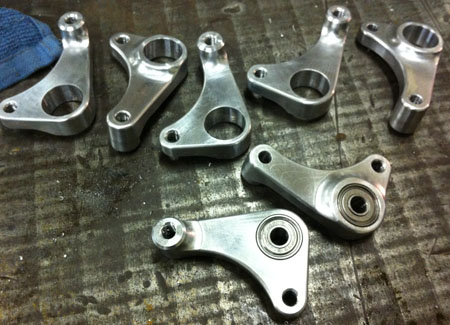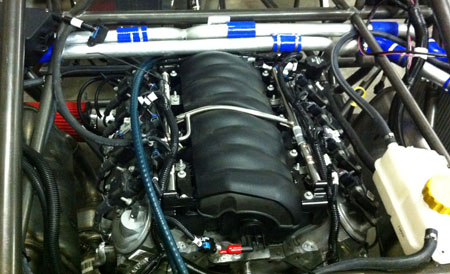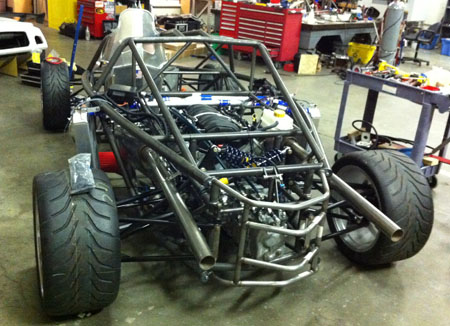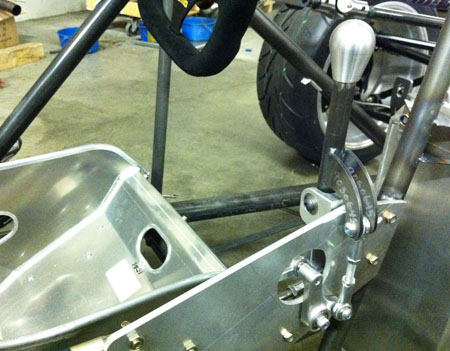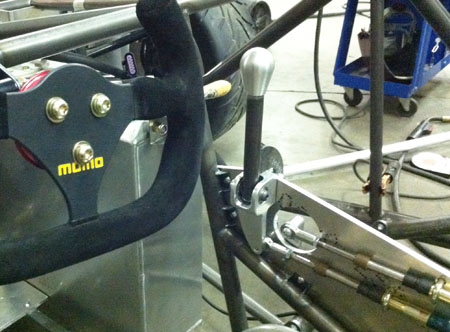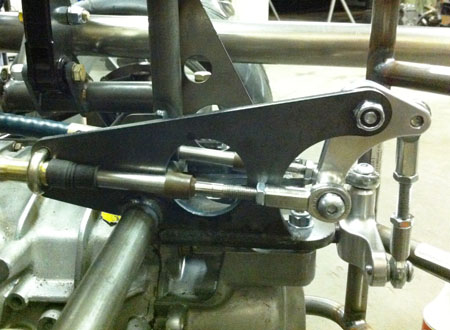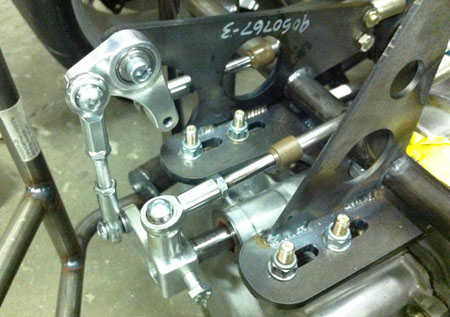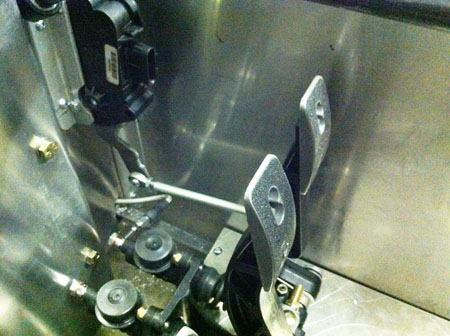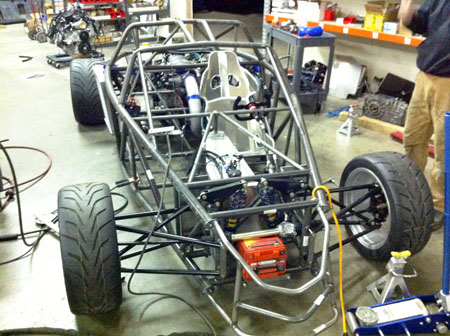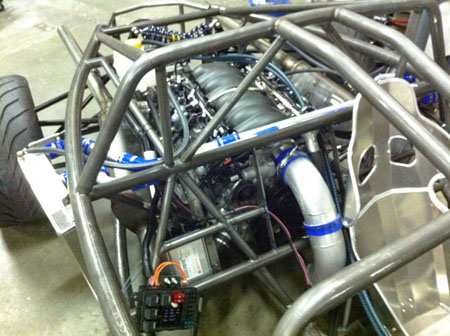|
10/19/12 A few steps closer to the goal. The steering is complete and the wheel is now fully mounted. I've tried quite a few quick-release hubs and they all have some amount of play in them which is annoying. Some are much worse than others. This particular one from Woodward is not too bad and is probably the best I've seen so far but there's still a very slight amount of slop there. It's an optional item so it will be up to the customer to decide whether they want to put up with it in order to get a quick-release wheel.
Also, this being a street-oriented car with 2.66 turns lock-to-lock the open top wheel wouldn't necessarily be everyone's first choice (quicker ratios are optional). The steering effort is very reasonable though. We're happy to build the car to customer preference whether it's street or track. Other items on the completed list are exhaust and radiator mounts. Normally I would come up with the design in SolidWorks and Tristan would build it. This time, since he's the one who has to fabricate the stuff, I've asked him to do the mounts and I'll put them in CAD after they're done. Turned out pretty well.
Much more to go but the list is getting shorter. I have been designing lots of parts and we will be placing another sheetmetal order Monday. Brackets, bulkheads and so forth. Then a lot of CNC machining. One final bit of news - we have a fourth D2 order, with money down. It is conditional on us being able to show a running car by December 1 (no bodywork). Fair enough. And of course I want to thank the lead customers for their patience and support. Not only have they facilitated the progerss made to date, they have influenced the design in very significant ways. It's awesome to have input from people with a vested interest in the outcome. On with the work then. 10/30/12 For the last couple days the D2 has been waiting for the latest batch of laser-cut sheetmetal to arrive. It's due tomorrow. Every project has its downtimes which is why it's very efficient to have several of them going at once. We've used the break to make D4 progress (see its own page), catch up on some CNC machining, get the Pikes Peak sponsor shirts ready to ship and a myriad other tasks. All this doesn't mean that the D2 is completely idle. The fuel cell is now here.
One of our lead customers dropped by to check on progress and we used the opportunity to verify the new seat configuration. Adam is 6'3" so I was anxious to see how well the revised ergonomics work for him. Earlier there were some concerns...
Fortunately the new setup addresses all the earlier issues and is as comfortable for Adam as it is for me. Also, I was originally thinking that the 15" wide seat is a little narrow but so far everyone who has tried it not only fit but liked it. So that will be the standard configuration (16, 17 and 18 inch widths are also available and will be no-cost options). Another thing I've spent some time on is the intake. Initially it looked like I could make it work with the turned-around manifold and a bunch of insulation. The more I tinkered with it the less elegant the solutions looked. So I decided to go back to a standard forward-facing manifold. Now that the fuel cell is forward there is enough room for a proper intake. Of course the airbox eats up all the space behind the driver's seat (passenger side is still open for storage) but I like this configuration a whole lot better. The intake is highlighted in blue in the pictures below.
Overall the car is coming together quite nicely. We do have lots of work ahead still. Many parts are on their way. I've ordered an alternator and a serpentine belt tensioner. When they arrive in a couple of days I'll figure out the custom brackets and determine which belt can be made to work best. Just about every aftermarket and factory LS accessory drive setup I've seen includes power steering pump which we don't have. And they're expensive, too! So once again a custom solution is called for. We do this a lot. 11/08/12 The detail work continues, iterating between design changes and actual fabrication. As the various pieces take their near-final shape it becomes clear that others have to change around them. The front bulkhead is here and installed, meaning that the fuel cell could now be mounted as well.
Likewise for all the seat hardware. Still some adjustments to make but overall it works quite well.
Many updates are happening in CAD also, ranging from getting radiator mounts into digital form to refining the intake shape before it's made, tweaking the gearbox mounts, alternator brackets and belt, the shifter and pedal details and so on.
Expect a lot of visible progress next week. 11/11/12 Here's a quick example of detailed design iterations. With all the recent changes (intake orientation being the major one) the shifter and transaxle mounting bracket needed to be updated. The shifter mechanism is a pretty complex 3D puzzle with many interconnected parts each of which has a range of motion. Even in Solidworks it's not a trivial task but the software does make it easier to tweak the relationships and check function.
After many revisions it turns out that over the top of the engine is the most efficient cable routing. Around the sides is not any shorter and would put the cables next to exhaust headers which is not good. Top routing will keep things reasonably cool, the paths are not too bad length-wise and bend radii are at least double the minimum allowed for the cables. This configuration is for the short G50 box which is what is in the first car. The second car will have a long G50 and the third a G96, both of which will require unique setups. But after the first one is done the subsequent ones should go quicker. It's always easier to modify an existing, working setup than to create something from scratch. Another quick item is another small step in the evolution of the bodywork which is tied to progress on the interior paneling. After receiving the aluminum front bulkhead I was reassured that laser-cut sheetmetal is an effective technology for paneling even in low quantities. Therefore the floor, rear bulkhead and side panels will be made this way (and powdercoated, black is the standard color). Trying the side panels several different ways they really work best on the outside of the frame. So with that, the sculpted composite side panels will be optional and those wanting the cleaner look can just leave them out. So I did a quick test to see what it would look like. Keep in mind the pictures below are just a very rough conceptual test (only spent 10 minutes on it!) - obviously the parts would be better finished and I have to figure out how the optional panels will integrate so that the car looks complete both with and without. That's a lot of work and will come later, after first drive.
This coming week will be a lot of fabrication and assembly. Lots of parts are on order and due in, a few more still to be ordered and a number of them have to be machined on the CNC. Both Tristan and I will be quite busy! 11/16/12 Plumbing is one more area where I've asked Tristan to figure it out in real life and will later put it in CAD. Part of the reason is that it has to fit around things that might not be in the model or may not be accurate (the engine that's in the car is slightly different from the one we have data for, including things like water pump outlet location). The other part is that it's just more efficient this way. He's doing a great job of it, too, with it being one of the cleaner plumbing installs we've done.
The final bit of this puzzle is that I've been working on a lot of other things that also need to get done. There are many parts to be machined still - shifter bits, pedals, floating rotor brake hats and so on. What's more, every one of these parts is going to require softjaw tooling - basically chunks of aluminum that are bolted to a vise and machined to precisely fit a particular part in order to hold it for machining. The conventional way is to use fairly low-precision blocks that can be bought as standard items. The problem is alignment - you have to machine reference edges into the tooling and then later set up the machine coordinates based on those edges in order to make parts accurately. All of which takes time and introduces opportunities for errors, some of which can get expensive. With the number of parts we're doing I wanted a more efficient way which meant designing and machining precision blanks that have alignment features built in so the setup is a 'no-brainer'. That's what I did today. The parts are reversible too so we can use both sides. Tristan asked if we have the time for this - my reply was that we don't have enough time NOT to do it. So, this weekend I will be machining the actual parts, now that I have enough fixturing. But in the meantime a few other things have been done. The shifter lever is one of them.
After researching batteries I've settled on the Odyssey PC1200 as the 'standard' for this car (pending verification by testing). It's quite a bit heavier than the PC680 we use in the D4s (37 lbs vs 15) but that's what the big V8 demands. A mount will be fabricated shortly.
The general plan is still to use our own pedal set which I will start machining in the next couple of days. But as a contingency (gotta have those) I made provisions for using a Tilton setup which we happen to have as a temporary stand-in. Doesn't get us the adjustment range we want due to forward-facing masters but will do for the first drive.
Yes, the first drive will happen without a real floor - it's not strictly needed for that. I'm still working out the details of it (and many other panels) but getting the car running is an important milestone so I'm not going to let little things like unfinished custom parts hold us back. A somewhat humorous observation - as you see this car take shape (and those that came before it), what's interesting is that none of us have any formal training in what we do. I'm a computer engineer. Tristan is a graphic designer (well, he does create our website and all promotional material too but that's a small fraction of his efforts). M pursued 'general studies' in college. Yet the three of us are cranking out on the average one fully new car design per year. And even finding time to race them with some success :) Politicians should take note - if you want to keep this country competitive, support people like us. Yea right. They'd rather spend $4B on TV ads with net zero gain (things are exactly as they were before that money was spent). What a world we live in. Well, enough of that, we have cars to make. 11/20/12 The pictures tell the story...
One week to go, much more to come. 11/24/12 I spent Thanksgiving making shifter parts and was actually glad to :) There is much to be thankful for. I did pause to reflect that I'm basically living the dream that I started pursuing some 10 years ago with my first design. Well, there's much more to accomplish of course but I am indeed doing it. Part of the price is that I haven't had a day off in over a month but that's what it takes.
Yesterday (Friday) a shipment we were expecting didn't show up so things will get pushed back a day or two. Some people apparently take holidays off? Guess they're not living the dream! :) Today I worked mostly on the wiring. The GM e-Rod wiring harness comes with the engine and it's pretty complete. I did have to make some modifications to make it work in our cars. No changes to wires themselves but to routing - which meant opening up the bundles, extracting the wires in question and then re-wrapping everything. Tedious work. It is made a little easier by having more than one engine so I could fit everything on one out in the open before tackling the tight packaging of the car itself. Still some work to do tomorrow but it's getting there. Looking more like a real car every day. Interestingly, wire harnesses from two different engine kits (same part number) are not identical. Functionally they're the same but there are differences in wire routes and lengths.
The list of things to be done before the first drive is getting shorter every day. We're almost there. 11/26/12 Not quite yet. But almost. The remainder of shifter hardware bits are now here so that's done and it works. Oil is in the gearbox and of course the engine was shipped to us with oil. So fluids-wise only brakes, clutch and coolant remain.
Floating rotor brakes are assembled and mounted.
The linkage from the pedals to the GM e-Rod electronic pedal sensor is figured out and made. Came out pretty clean actually and gives us control over pedal travel.
Battery is mounted, as is ECU. Location for the fuse box is figured out.
Tristan is finishing up the controls plumbing while I'm doing the last of the wiring. More parts expected tomorrow. It could be the day... Well at least that'll be the last of the dry weather for a while so I'm hoping we don't miss it (more than just hoping obviously).
|
